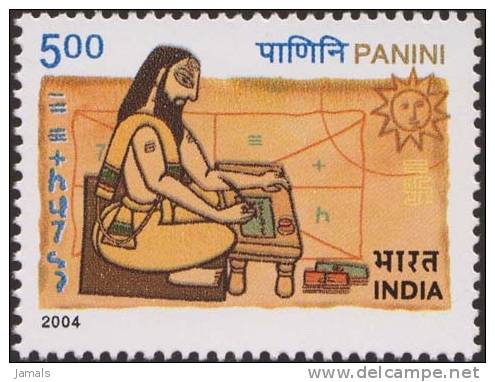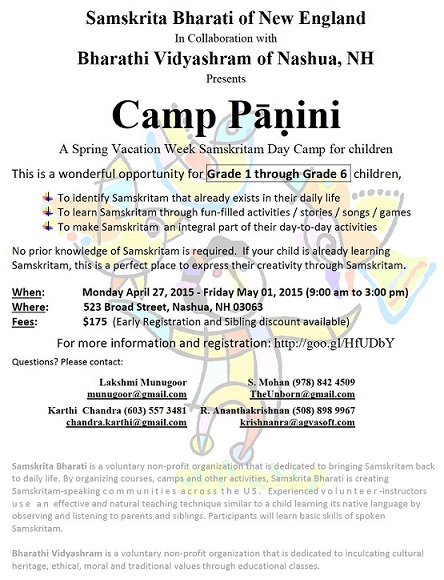Contribute
| Come Learn The Language Of The Gods |
K. Arvind
03/25/2015
Come Learn the Language of the Gods Sanskrit Camp Panini at the Hindu Temple of New Hampshire K. Arvind अइउणॠऋऌकॠà¤à¤“ङॠà¤à¤”चॠहयवरटॠलणॠञमङणनमॠSamskrita Bharati of New England, in collaboration with Bharati Vidyasharam, cultural wing of the Hindu Temple of New Hampshire, Nashua, NH is happy to announce Camp Panini, a week long Sanskrit day camp for children in grades 1 through 6, during the New Hampshire Spring vacation week (Monday April 27, 2015-Friday, May 1, 2015, 9:00 AM-3 PM). Samskrita Bharati and Bharathi Vidyashram encourage parents in the Greater Boston area to make use of this wonderful opportunity to introduce their children to the gift of Sanskrit. Sanskrit is not Alien A few years ago, a former colleague of mine, whose name suggests that he is of the Islamic faith, mentioned one day that he was taking the day off to celebrate Nowruz, which falls around March 21st. I was not sure then what exactly “Nowruz†was, and told him that if “Nowruz†were a Hindi word, it might mean “new dayâ€. He then explained that “Nowruz†in fact meant “new day†and was actually the Persian New Year’s day. This led to an interesting conversation and exchange of knowledge about languages that revealed to me, that there is actually a surprisingly close relationship between Sanskrit, the language of Hindu scriptures, and Persian, a language spoken in some Islamic countries. Consider the numbers from 1 to 10 for example: # Sanskrit Persian # Sanskrit Persian 1 eka (à¤à¤•) ek (یک) 6 shash (षषà¥) shesh (شش) 2 dvi (दà¥à¤µà¤¿) do (دو) 7 saptan (सपà¥à¤¤à¤¨à¥) haft (Ù‡Ùت) 3 tri (तà¥à¤°à¤¿) se (سه) 8 ashtan (अषà¥à¤Ÿà¤¨à¥) hasht (هشت) 4 chatur (चतà¥à¤°à¥) chahar (چهار) 9 navan (नवनà¥) no (نه) 5 panchan (पञà¥à¤šà¤¨à¥) panj (پنج) 10 dashan (दशनà¥) dah (ده) Sanskrit is Thriving All of this goes to illustrate that Sanskrit, which many Indians living in the West tend to dismiss as a relic of the distant past, is very much part of the English speaking world. Sanskrit is not only intimately related to the languages of the Western world (listen to “History of Englishâ€), but it is also a storehouse of Indian wisdom (which is so sought after in the West) and an excellent vehicle to transmit this wisdom to future generations. Sanskrit is known as “deva-bhashaaâ€, the language of the gods. The great works in the Indian spiritual tradition such as the Ramayana, Mahabharata, Bhagavad Gita, Srimad Bhagavatham, Patanjali’s Yoga Sutras, and the Vedas are in Sanskrit. Knowing Sanskrit allows you to study, understand, interpret and appreciate these works yourself. Jawaharlal Nehru, the first Prime Minister of India, asserts in his “Discovery of India†(video link) – “If I was asked, what is the greatest treasure which India possesses, and what is her finest heritage, I would answer unhesitatingly that it is the Sanskrit language and literature and all that it contains.†Sanskrit is a scientifically designed language - in fact “Samskrutamâ€, the Sanskrit word for Sanskrit means “well-constructedâ€. Sanskrit enjoys wide respect in the West, as this interview with Prof. Dean Brown, physicist and computer scientist (one of the creators of the Z80 microprocessor) illustrates. This video reports on how Sanskrit is thriving in schools in London, and this one captures a day of teaching Sanskrit at St. James School, London. Here is a video of British children chanting Sanskrit hymns in the Buckingham Palace, London, and here is a video of a couple of American youth chanting the Sri Rudram at a spiritual conference held in the White House, Washington, D.C. Sanskrit is Easy to Learn Sanskrit is not very difficult to learn, and it is not difficult to find Sanskrit speakers (you can even receive your newscast in Sanskrit). The National Sanskrit Center (“Rashtriya Sanskrit Sansthaanâ€) in India has released an excellent DVD series titled “Samskrita Bhasha Shikshanam†that allows anyone to pick up spoken Sanskrit with ease. Samskrita Bharati USA, a non-profit organization working to revive Sanskrit, provides many immersive opportunities for adults, youth and children living in the United States to acquire proficiency in Sanskrit. Samskrita Bharati offers a course of study for youth called “Sanskrit as a Foreign Language†(SAFL), and is engaged with various school districts in the United States to recognize the course for high school academic credit. Samskrita Bharati also offers classes for adults, weekend camps and yearly residential camps, as well as a distance learning program. Camp Panini for Children Samskrita Bharati of New England, in collaboration with Bharati Vidyasharam, cultural wing of the Hindu Temple of New Hampshire, Nashua, NH is happy to announce Camp Panini. The camp is named after Panini, the great Sanskrit Grammarian from ancient India, whose highly systematized work called the “Ashtadyayiâ€, captures the entire grammar of Sanskrit in a compact meta-language consisting of about 4000 short aphorisms or “sutrasâ€, and some of whose analyses form part of the basis of modern linguistics. Camp Panini is a week-long Sanskrit day camp for children in grades 1 through 6, during the New Hampshire Spring vacation week (Monday April 27, 2015-Friday, May 1, 2015, 9:00 AM-3 PM). This is a wonderful opportunity for young children to be introduced to Sanskrit, to identify Sanskrit that already exists in their daily life, to learn Sanskrit through fun-filled activities, and to make Sanskrit an integral part of their daily activities. No prior knowledge of Sanskrit is required. For more information and registration: http://goo.gl/HfUDbY. नृतà¥à¤¤à¤¾à¤µà¤¸à¤¾à¤¨à¥‡ नटराज-राजो ननाद ढकà¥à¤•à¤¾à¤‚ नवपञà¥à¤šà¤µà¤¾à¤°à¤®à¥ | Nruttaavaasane natarajarajo nanaada dakkaam navapanchavaaram | At the end of his cosmic dance, Shiva, the Lord of Dance, with a view to (Versification of the legend of the revelation to Panini of the “Maaheswara Sutras†that organize Sanskrit phonemes)
à¤à¤à¤žà¥ घढधषॠजबगडदशॠखफछठथचटतवॠकपयॠशषसरॠहलà¥
(Panini’s Maaheswara Sutrani – chanted by Maestro Ilayaraja, and rapped and danced by gen-Y youth)
The similarities in the way the numbers 1 through 10 are pronounced in Sanskrit and Persian was a personal epiphany to me. As I explored this further, I learned that it is not only Sanskrit and Persian that are related. An entire collection of languages that I had classified up to that point in my mind as polar opposites of Sanskrit also turned out to be cognate with Sanskrit. This collection includes Greek, Latin, German, French, Spanish and even English. Have you ever wondered why some words that denote close family relationships sound so similar in languages that seem to have no obviously visible connections? For example, the words for “fatherâ€, “motherâ€, “brother†and “daughter†in Sanskrit, namely “pitr†(पितृ), “maatr†(मातृ), “bhraatr†(à¤à¥à¤°à¤¾à¤¤à¥ƒ) and “duhitr†(दà¥à¤¹à¤¿à¤¤à¥ƒ) have recognizably close pronunciations with their English counterparts. The Sanskrit word “vid†(विदà¥) which the words “veda†(scriptures) and “vidya†(knowledge) are derived, is related to the Latin word “videre†(to see) from which the English words “video†and “vision†are derived. This should no doubt provide some consolation to parents of children who prefer to play video games than study to acquire knowledge. These unbelievable connections between languages spoken in vastly separated geographic regions, were first discovered in Calcutta, India in the late 1700’s by a British judge Sir William Jones, who was proficient in Persian and multiple European languages, and who started learning Sanskrit in order to understand Indian legal traditions or shaastras. The revelation of these connections seems to provide a new and concrete meaning to the Indian saying that the world is one family (वसà¥à¤§à¥ˆà¤µ कà¥à¤Ÿà¥à¤®à¥à¤¬à¤•à¤®à¥ – Vasudhaiva Kutumbakam)!
उदà¥à¤§à¥à¤°à¥à¤¤à¥à¤•à¤¾à¤®: सनकादिसिदà¥à¤§à¤¾à¤¨à¥ à¤à¤¤à¤¦à¥à¤µà¤¿à¤®à¤°à¥à¤·à¥‡ शिवसूतà¥à¤°à¤œà¤¾à¤²à¤®à¥ ||
Udhdhartukamah sanakadisiddhadinetadvimarshe shivasootrajaalam ||
bless the sages Sanaka and others, played on his damaru fourteen times,
from which emerged the following fourteen sutras, popularly known as the Shiva sutras.

You may also access this article through our web-site http://www.lokvani.com/

